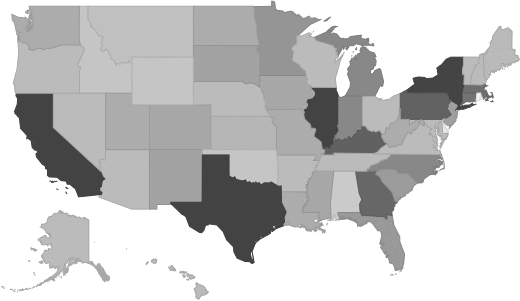Port Services and Warehousing for Maritime Transportation Industry - Market Research Report
Industry Overview
This industry group comprises establishments primarily engaged in one of the following: (1) operating ports, harbors (including docking and pier facilities), or canals; (2) providing stevedoring and other marine cargo handling services (except warehousing); (3) providing navigational services to shipping; or (4) providing other services to water transportation.
Source: U.S. Census BureauMarket Size and Industry Forecast
This research report analyzes the market size and trends in the Port Services and Warehousing for Maritime Transportation industry. It shows overall market size from 2020 to the present, and predicts industry growth through 2030. Revenues data include both public and private companies.
| Historical | Forecasted |
|---|
| 2020 | 2021 | 2022 | 2023 | 2024 | 2025 | 2026 | 2027 | 2028 | 2029 | 2030 |
|---|
| Market Size (Total Revenue) | Included in Report |
| % Growth Rate |
| Number of Companies |
| Total Employees |
| Average Revenue per Company |
| Average Employees per Company |
Source: U.S. government financial dataIndustry Revenue ($ Billions)

Industry Forecast ($ Billions)

Advanced econometric models forecast five years of industry growth based on short- and long-term trend analysis. Market size includes revenue generated from all products and services sold within the industry.
Geographic Breakdown by U.S. State
Market size by state reveals local opportunity through the number of companies located in the region. Each state's growth rate is affected by regional economic conditions. Data by state can be used to pinpoint profitable and nonprofitable locations for Port Services and Warehousing for Maritime Transportation companies in the United States.
Port Services and Warehousing for Maritime Transportation Revenue by State

Distribution by Company Size
| Company Size | All Industries | Port Services and Warehousing for Maritime Transportation |
|---|
| Small Business (< 5 Employees) | Included |
| Small Business (5 - 20) |
| Midsized Business (20 - 100) |
| Large Business (100 - 500) |
| Enterprise (> 500) |
Port Services and Warehousing for Maritime Transportation Industry Income Statement (Average Financial Metrics)
Financial statement analysis determines averages for the following industry forces:
- Cost of goods sold
- Compensation of officers
- Salaries and wages
- Employee benefit programs
- Rent paid
- Advertising and marketing budgets
The report includes a traditional income statement from an "average" company (both public and private companies are included).
| Industry Average | Percent of Sales |
|---|
| Total Revenue | Included |
| Operating Revenue |
| Cost of Goods Sold (COGS) |
| Gross Profit |
| Operating Expenses |
| Operating Income |
| Non-Operating Income |
| Earnings Before Interest and Taxes (EBIT) |
| Interest Expense |
| Earnings Before Taxes |
| Income Tax |
| Net Profit |
Average Income Statement

Cost of Goods Sold
Salaries, Wages, and Benefits
Rent
Advertising
Depreciation and Amortization
Officer Compensation
Net Income
Financial Ratio Analysis
Financial ratios allow a company's performance to be compared against that of its peers.
| Financial Ratio | Industry Average |
|---|
| Profitability Ratios | Included |
| Profit Margin |
| ROE |
| ROA |
| Liquidity Ratios |
| Current Ratio |
| Quick Ratio |
| Activity Ratios |
| Average Collection Period |
| Asset Turnover Ratio |
| Receivables Turnover Ratio |
| Inventory Conversion Ratio |
Products and Services Mix
Product lines and services in the Port Services and Warehousing for Maritime Transportation industry accounting for the largest revenue sources.
| Product Description | Description | Revenue
($ Millions) |
|---|
| Industry total | Included |
| Warehousing services |
| Warehousing services - handling of goods |
| Marine facility services |
| Tugboat services |
| Maintenance and repair services for maritime vessels |
| Trans of other intermodal containers, nec, by water |
| Marine salvaging services |
| Navigational services to shipping |
| Towing services |
Salary information for employees working in the Port Services and Warehousing for Maritime Transportation industry.
| Title | Percent of Workforce | Bottom Quartile | Average (Median) Salary | Upper Quartile |
|---|
| Management Occupations | 4% | Included |
| Chief Executives | 0% |
| General and Operations Managers | 2% |
| Office and Administrative Support Occupations | 10% |
| Installation, Maintenance, and Repair Occupations | 7% |
| Transportation and Material Moving Occupations | 71% |
| Water Transportation Workers | 20% |
| Sailors and Marine Oilers | 9% |
| Sailors and Marine Oilers | 9% |
| Ship and Boat Captains and Operators | 9% |
| Captains, Mates, and Pilots of Water Vessels | 8% |
| Material Moving Workers | 39% |
| Industrial Truck and Tractor Operators | 6% |
| Industrial Truck and Tractor Operators | 6% |
| Laborers and Material Movers, Hand | 25% |
| Laborers and Freight, Stock, and Material Movers, Hand | 25% |
Government Contracts
The federal government spent an annual total of
$337,127,125 on the port services and warehousing for maritime transportation industry. It has awarded 5,659 contracts to 287 companies, with an average value of $1,174,659 per company.
Top Companies in Port Services and Warehousing for Maritime Transportation and Adjacent Industries
| Company | Address | Revenue
($ Millions) |
|---|
Included |



